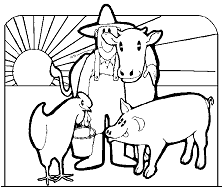Water: Middle School
Exercise I. Old MacDonald's Farmland Fertilizer Dilemma
Old MacDonald's Farm

Why Worry About Old MacDonald?
Old MacDonald has some big decisions to make. In this exercise, you will help him decide how much fertilizer his crops need. At the same time you will help him to keep costs down and prevent nutrient runoff into nearby lakes and streams.
Verse 1:
Old MacDonald had a farm. . . E-I-E-I-O
And on this farm he had 900 chickens. . . E-I-E-I-O
with a cluck-cluck here and a cluck-cluck there,
here a cluck,
there a cluck,
everywhere a cluck-cluck
Old MacDonald had a farm. . . E-I-E-I-O
Verse 2:
And on this farm he had 10 pigs
Verse 3:
And on this farm he had 12 cows
Old MacDonald has a small farm. The cows graze in a 15-acre pasture, and he grows corn to feed his chickens, pigs, and cows in a 35-acre field. Altogether, Old MacDonald's animals produce about 170 tons of manure every year! That manure contains 1,200 pounds of nitrogen and 800 pounds of phosphorus.
 Old MacDonald knows that manure is an unbalanced fertilizer for corn because it has too much phosphorus and not enough nitrogen. Corn plants use 5 to 20 times as much nitrogen as phosphorus, and there is less than twice as much nitrogen than phosphorus in manure. Farmers usually apply manure to fulfill the nitrogen requirements for crops. Because crops do not use up the phosphorus in the manure, the result is an overapplication of phosphorus. This phosphorus then builds up in the soil until a rainstorm washes it into nearby streams or rivers, where it can cause water quality problems and threaten aquatic life.
Old MacDonald knows that manure is an unbalanced fertilizer for corn because it has too much phosphorus and not enough nitrogen. Corn plants use 5 to 20 times as much nitrogen as phosphorus, and there is less than twice as much nitrogen than phosphorus in manure. Farmers usually apply manure to fulfill the nitrogen requirements for crops. Because crops do not use up the phosphorus in the manure, the result is an overapplication of phosphorus. This phosphorus then builds up in the soil until a rainstorm washes it into nearby streams or rivers, where it can cause water quality problems and threaten aquatic life.
Solving the Problem
Old MacDonald wants to fertilize his pasture and cornfields with the manure that his cows, chickens, and pigs produce. After all, it's free, and he doesn't have to haul it from somewhere else! And commercial fertilizer is expensive-nitrogen costs 15 cents per pound and phosphorus costs 50 cents per pound.
However, his choice is not easy. Either he spreads enough manure so that the crops get enough nitrogen (leaving large amounts of leftover phosphorus that could run off into streams and lakes), or he spreads only enough manure so that the crops get the right amount of phosphorus (but not enough nitrogen).
 After testing the soil, Old MacDonald is able to determine that the pasture requires 80 lb/acre of nitrogen and 5 lb/acre of phosphorus for the best growth. He also discovers that his corn crop needs 125 lb/acre of nitrogen and 25 lb/acre of phosphorus for the best growth.
After testing the soil, Old MacDonald is able to determine that the pasture requires 80 lb/acre of nitrogen and 5 lb/acre of phosphorus for the best growth. He also discovers that his corn crop needs 125 lb/acre of nitrogen and 25 lb/acre of phosphorus for the best growth.
Fill in the table below with information from the preceding paragraphs.
| Number | Units | |
| Pasture size |
||
| Cornfield size |
||
| Manure produced |
||
| Nitrogen in manure |
||
| Phosphorus in manure |
||
| Cost for extra nitrogen |
||
| Cost for extra phosphorus | ||
| Nitrogen needed to fertilize pasture | ||
| Phosphorus needed to fertilize pasture | ||
| Nitrogen needed to fertilize corn | ||
| Phosphorus needed to fertilize corn |
Doing the Calculations . . .
Part I. Find the amounts of nitrogen and phosphorus required on the farm:
- How much nitrogen does Old MacDonald need to fertilize his farm?
acres pasture x
lbs nitrogen per acre =
lbs +
acres cropland x
lbs nitrogen per acre =
lbs
lbs = nitrogen requirement Remember your order of operations.
Multiplication is done before addition. - Now compare the amount of nitrogen required on the farm to the amount of nitrogen in the manure. Is there enough nitrogen in the manure to fertilize both the pasture and corn?
- How much more nitrogen does he need?
- How much phosphorus does Old MacDonald need to fertilize his farm?
acres pasture x
lbs phosphorus per acre =
lbs +
acres cropland x
lbs phosphorus per acre =
lbs
lbs = phosphorus requirement
- Now compare the amount of phosphorus required on the farm to the amount of phosphorus in the manure. Is there enough phosphorus in the manure to fertilize both the pasture and corn?
- How much more phosphorus does Old MacDonald need?
Part II.
Option 1: Fertilize with enough manure to meet nitrogen needs
 From the calculations in Part I, we discovered that the pasture needs 1,200 pounds of nitrogen. This is exactly the amount of nitrogen contained in the manure produced on Old MacDonald's farm. So, let's assume that Old MacDonald uses all the manure to fertilize his pasture. This will completely satisfy the pasture's need for nitrogen and phosphorus. However, he still needs to fertilize his corn crop.
From the calculations in Part I, we discovered that the pasture needs 1,200 pounds of nitrogen. This is exactly the amount of nitrogen contained in the manure produced on Old MacDonald's farm. So, let's assume that Old MacDonald uses all the manure to fertilize his pasture. This will completely satisfy the pasture's need for nitrogen and phosphorus. However, he still needs to fertilize his corn crop.
Because Old MacDonald used all the manure produced on his farm to fertilize his pasture, he must buy commercial fertilizer for his corn. He needs to buy both nitrogen and phosphorus.
- How many pounds of nitrogen would Old MacDonald need to buy? Hint: Look at your calculations in #1.
-
-
How much would Old MacDonald have to pay to buy enough commercial nitrogen?
-
How many pounds of phosphorus would Old MacDonald have to buy? Hint: Look at your calculations in #3.
-
How much would Old MacDonald have to pay to buy enough commercial phosphorus?
-
How much would Old MacDonald spend in all on commercial fertilizer for Option 1?
Option II. Fertilize with enough manure to meet phosphorus needs
Old MacDonald does not have to use all the manure from his farm to fertilize his pasture. From the calculations in Part I, we found that if Old MacDonald puts some of the manure on the pasture and some on the corn field according to the amount of phosphorus each field needs, he will need to buy only 150 pounds of phosphorus. However, he will then have to put nitrogen on both his pasture and his corn field. Will this method of distributing fertilizer be worth it? Let's find out.
- After spreading manure according to the phosphorus needs of each field, how many pounds of phosphorus would Old MacDonald need to buy?
-
-
Find the total price that Old MacDonald would have to pay for commercial phosphorus.
-
How many pounds of nitrogen would Old MacDonald have to buy? Hint: Subtract the total amount of nitrogen Old MacDonald needs from the amount of nitrogen in the manure that he spread.
-
Find the total price that Old MacDonald would have to pay for commercial nitrogen.
-
How much would Old MacDonald spend in all on commercial fertilizer for Option 2?
Other Farmer-ly Considerations...
Manure also contains other nutrients such as manganese, calcium, sulphur, boron, and iron that plants need to survive. If Old MacDonald applies manure only to his pastureland (as was the case for nitrogen-based application), he might still have to buy and apply these additional nutrients to satisfy crop needs.Manure application will also increase the health of the soil because manure contains organic matter that is used as food by worms and other organisms in the soil. The result is a healthier soil that grows healthier crops while, at the same time, reducing the environmental damage of excess nutrient runoff into lakes and streams.

Making the Right Decision
- Which is cheaper for Old MacDonald, Option 1 or Option 2?
-
- How much would Old MacDonald save if he used the cheaper method?
-
-
Which method of fertilization would lead to less excess phosphorus accumulation in the soil? (Remember that excess phosphorus in the soil is washed away by rainwater and leads to pollution in nearby waterways.)
